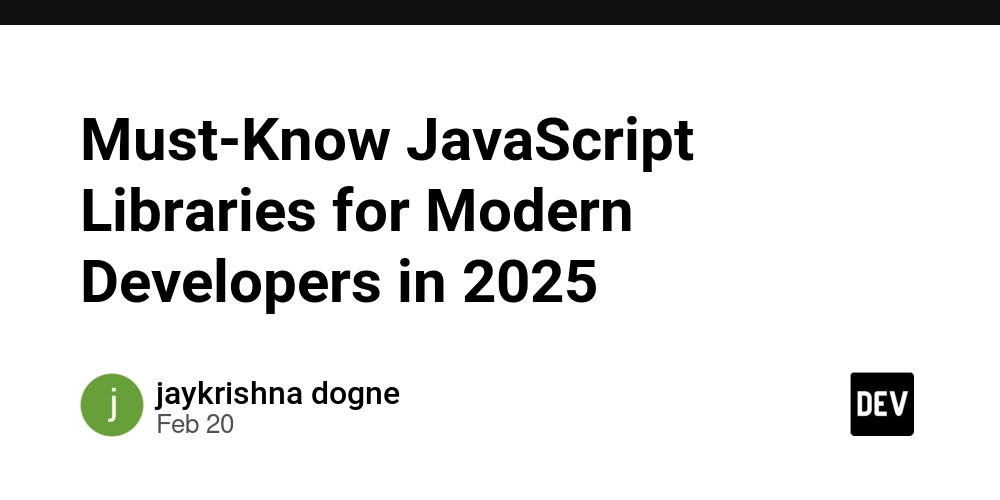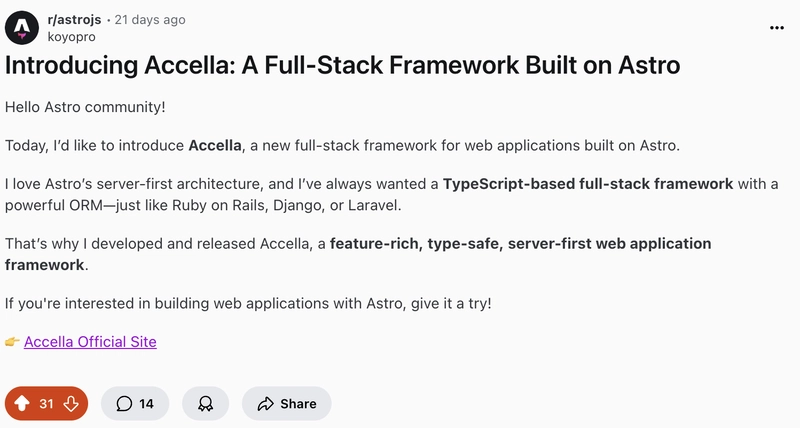Must-Know JavaScript Libraries for Modern Developers in 2025
JavaScript continues to dominate web development, and staying updated with the latest libraries can boost your efficiency, improve performance, and make development smoother. Whether you're working on frontend, backend, or full-stack projects, these libraries will help you stay ahead. 1️⃣ React.js – The Ultimate UI Library React.js remains one of the most popular choices for building dynamic and high-performing UIs. ✅ Component-based architecture ✅ Virtual DOM for efficient rendering ✅ Huge ecosystem with Next.js, Redux, and React Query Used for SPAs, dashboards, e-commerce sites, and interactive UIs. 2️⃣ Next.js – The React Framework for Speed & SEO If you’re using React, Next.js offers server-side rendering (SSR), static site generation (SSG), and API routes. ✅ Fast performance with automatic optimization ✅ Built-in image optimization and internationalization ✅ Hybrid rendering (SSR + SSG) Ideal for SEO-friendly blogs, SaaS applications, and e-commerce sites. 3️⃣ Vue.js – Lightweight & Easy-to-Learn UI Framework Vue.js is known for its simplicity and flexibility. ✅ Reactive data binding with Vue 3’s Composition API ✅ Lightweight and fast ✅ Easy integration with existing projects Great for interactive web apps, prototypes, and small-to-medium projects. 4️⃣ Svelte – The Future of Web Frameworks? Svelte compiles code into highly optimized JavaScript, removing the need for a virtual DOM. ✅ No virtual DOM, resulting in faster apps ✅ Less boilerplate code ✅ Built-in stores for state management Perfect for small-to-medium apps, animations, and performance-critical applications. 5️⃣ Express.js – The Minimalist Backend Framework Express.js is widely used for backend development with Node.js. ✅ Lightweight and unopinionated ✅ Middleware support for extensibility ✅ Works seamlessly with MongoDB, PostgreSQL, and GraphQL Great choice for REST APIs, microservices, and full-stack applications. 6️⃣ NestJS – TypeScript-Powered Backend Framework NestJS brings a structured approach to Node.js development, making backend apps scalable and maintainable. ✅ Built-in TypeScript support ✅ Modular architecture for enterprise-level projects ✅ Supports GraphQL, WebSockets, and microservices Useful for scalable enterprise apps, APIs, and backend services. 7️⃣ Axios – The Best HTTP Client for API Calls Axios simplifies fetching data from APIs with advanced features. ✅ Supports request/response interceptors ✅ Handles errors and automatic retries ✅ Works on both Node.js and browsers Commonly used for fetching APIs in frontend and backend applications. 8️⃣ Lodash – The Essential Utility Library JavaScript’s built-in utilities can be limited—Lodash provides optimized methods. ✅ Functions for arrays, objects, and strings ✅ Performance-optimized methods for deep clones, debouncing, and more ✅ Functional programming helpers Best suited for data manipulation and optimizing performance. 9️⃣ Chart.js – Interactive Charts & Data Visualization Chart.js simplifies adding responsive and interactive charts to applications. ✅ Supports various chart types (line, bar, pie, radar, etc.) ✅ Animation and customization options ✅ Works with React, Vue, and vanilla JS Great for dashboards, analytics, and data-heavy applications.

JavaScript continues to dominate web development, and staying updated with the latest libraries can boost your efficiency, improve performance, and make development smoother. Whether you're working on frontend, backend, or full-stack projects, these libraries will help you stay ahead.
1️⃣ React.js – The Ultimate UI Library
React.js remains one of the most popular choices for building dynamic and high-performing UIs.
✅ Component-based architecture
✅ Virtual DOM for efficient rendering
✅ Huge ecosystem with Next.js, Redux, and React Query
Used for SPAs, dashboards, e-commerce sites, and interactive UIs.
2️⃣ Next.js – The React Framework for Speed & SEO
If you’re using React, Next.js offers server-side rendering (SSR), static site generation (SSG), and API routes.
✅ Fast performance with automatic optimization
✅ Built-in image optimization and internationalization
✅ Hybrid rendering (SSR + SSG)
Ideal for SEO-friendly blogs, SaaS applications, and e-commerce sites.
3️⃣ Vue.js – Lightweight & Easy-to-Learn UI Framework
Vue.js is known for its simplicity and flexibility.
✅ Reactive data binding with Vue 3’s Composition API
✅ Lightweight and fast
✅ Easy integration with existing projects
Great for interactive web apps, prototypes, and small-to-medium projects.
4️⃣ Svelte – The Future of Web Frameworks?
Svelte compiles code into highly optimized JavaScript, removing the need for a virtual DOM.
✅ No virtual DOM, resulting in faster apps
✅ Less boilerplate code
✅ Built-in stores for state management
Perfect for small-to-medium apps, animations, and performance-critical applications.
5️⃣ Express.js – The Minimalist Backend Framework
Express.js is widely used for backend development with Node.js.
✅ Lightweight and unopinionated
✅ Middleware support for extensibility
✅ Works seamlessly with MongoDB, PostgreSQL, and GraphQL
Great choice for REST APIs, microservices, and full-stack applications.
6️⃣ NestJS – TypeScript-Powered Backend Framework
NestJS brings a structured approach to Node.js development, making backend apps scalable and maintainable.
✅ Built-in TypeScript support
✅ Modular architecture for enterprise-level projects
✅ Supports GraphQL, WebSockets, and microservices
Useful for scalable enterprise apps, APIs, and backend services.
7️⃣ Axios – The Best HTTP Client for API Calls
Axios simplifies fetching data from APIs with advanced features.
✅ Supports request/response interceptors
✅ Handles errors and automatic retries
✅ Works on both Node.js and browsers
Commonly used for fetching APIs in frontend and backend applications.
8️⃣ Lodash – The Essential Utility Library
JavaScript’s built-in utilities can be limited—Lodash provides optimized methods.
✅ Functions for arrays, objects, and strings
✅ Performance-optimized methods for deep clones, debouncing, and more
✅ Functional programming helpers
Best suited for data manipulation and optimizing performance.
9️⃣ Chart.js – Interactive Charts & Data Visualization
Chart.js simplifies adding responsive and interactive charts to applications.
✅ Supports various chart types (line, bar, pie, radar, etc.)
✅ Animation and customization options
✅ Works with React, Vue, and vanilla JS
Great for dashboards, analytics, and data-heavy applications.












































































































































































![[The AI Show Episode 142]: ChatGPT’s New Image Generator, Studio Ghibli Craze and Backlash, Gemini 2.5, OpenAI Academy, 4o Updates, Vibe Marketing & xAI Acquires X](https://www.marketingaiinstitute.com/hubfs/ep%20142%20cover.png)



























































































































![[DEALS] The Premium Learn to Code Certification Bundle (97% off) & Other Deals Up To 98% Off – Offers End Soon!](https://www.javacodegeeks.com/wp-content/uploads/2012/12/jcg-logo.jpg)


![From drop-out to software architect with Jason Lengstorf [Podcast #167]](https://cdn.hashnode.com/res/hashnode/image/upload/v1743796461357/f3d19cd7-e6f5-4d7c-8bfc-eb974bc8da68.png?#)









































































































.png?#)

































_Christophe_Coat_Alamy.jpg?#)
 (1).webp?#)




































































































![iPhone 17 Pro Won't Feature Two-Toned Back [Gurman]](https://www.iclarified.com/images/news/96944/96944/96944-640.jpg)
![Tariffs Threaten Apple's $999 iPhone Price Point in the U.S. [Gurman]](https://www.iclarified.com/images/news/96943/96943/96943-640.jpg)





































































































































